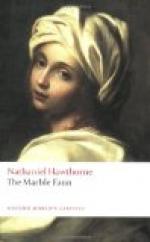The sculptor fancied, moreover (but perhaps it was his heresy that suggested the idea), that it would be of happy influence to place a comfortable and shady seat beneath every wayside shrine. Then the weary and sun-scorched traveller, while resting himself under her protecting shadow, might thank the Virgin for her hospitality. Nor, perchance, were he to regale himself, even in such a consecrated spot, with the fragrance of a pipe, would it rise to heaven more offensively than the smoke of priestly incense. We do ourselves wrong, and too meanly estimate the Holiness above us, when we deem that any act or enjoyment, good in itself, is not good to do religiously.
Whatever may be the iniquities of the papal system, it was a wise and lovely sentiment that set up the frequent shrine and cross along the roadside. No wayfarer, bent on whatever worldly errand, can fail to be reminded, at every mile or two, that this is not the business which most concerns him. The pleasure-seeker is silently admonished to look heavenward for a joy infinitely greater than he now possesses. The wretch in temptation beholds the cross, and is warned that, if he yield, the Saviour’s agony for his sake will have been endured in vain. The stubborn criminal, whose heart has long been like a stone, feels it throb anew with dread and hope; and our poor Donatello, as he went kneeling from shrine to cross, and from cross to shrine, doubtless found an efficacy in these symbols that helped him towards a higher penitence.
Whether the young Count of Monte Beni noticed the fact, or no, there was more than one incident of their journey that led Kenyon to believe that they were attended, or closely followed, or preceded, near at hand, by some one who took an interest in their motions. As it were, the step, the sweeping garment, the faintly heard breath, of an invisible companion, was beside them, as they went on their way. It was like a dream that had strayed out of their slumber, and was haunting them in the daytime, when its shadowy substance could have neither density nor outline, in the too obtrusive light. After sunset, it grew a little more distinct.
“On the left of that last shrine,” asked the sculptor, as they rode, under the moon, “did you observe the figure of a woman kneeling, with her, face hidden in her hands?”
“I never looked that way,” replied Donatello. “I was saying my own prayer. It was some penitent, perchance. May the Blessed Virgin be the more gracious to the poor soul, because she is a woman.”
CHAPTER XXXIII
PICTURED WINDOWS
After wide wanderings through the valley, the two travellers directed their course towards its boundary of hills. Here, the natural scenery and men’s modifications of it immediately took a different aspect from that of the fertile and smiling plain. Not unfrequently there was a convent on the hillside; or, on some insulated promontory, a mined castle, once the den of a robber chieftain, who was accustomed to dash down from his commanding height upon the road that wound below. For ages back, the old fortress had been flinging down its crumbling ramparts, stone by stone, towards the grimy village at its foot.




